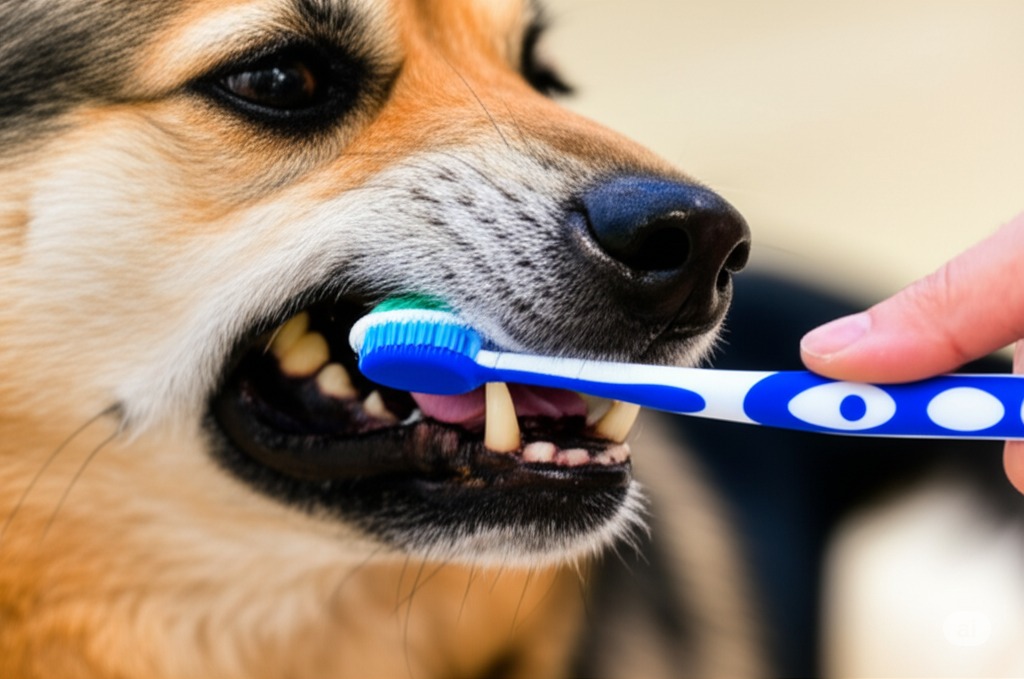Dog Dental Disease Prevention: Best Practices for Oral Health in Dogs
Dog Dental Disease Prevention: Best Practices for Oral Health in Dogs
Dog dental disease is one of the most common health problems affecting canines, with statistics suggesting that by the age of three, a vast majority of dogs show some signs of dental pathology. More than just bad breath, dog dental disease can lead to significant pain, tooth loss, and even systemic health issues affecting organs like the heart, kidneys, and liver. Unfortunately, it’s often overlooked by owners who may not realize the severity of the problem. This comprehensive guide will delve into the critical importance of dog dental disease prevention, outlining the best practices for maintaining optimal oral health in your dog, from daily brushing to professional cleanings, and exploring effective products and strategies.

The Silent Threat: Understanding Dog Dental Disease
Dog dental disease primarily refers to periodontal disease, an inflammatory condition affecting the tissues surrounding the teeth. It begins subtly and progresses through several stages:
- Plaque Formation: After eating, bacteria in the mouth mix with food particles and saliva to form a sticky, colorless film called plaque. This process starts almost immediately.
- Tartar (Calculus) Buildup: If plaque is not removed, it mineralizes and hardens into tartar (calculus) within days. Tartar is rough and porous, providing an ideal surface for more plaque to accumulate, creating a vicious cycle.
- Gingivitis: The bacteria in plaque and tartar irritate the gums, leading to inflammation, redness, and swelling – a condition known as gingivitis. This is the earliest stage of dog dental disease and is reversible with proper care.
- Periodontitis: If gingivitis is left untreated, the inflammation progresses. Bacteria move below the gumline, infecting the ligaments and bone supporting the teeth. This leads to the formation of periodontal pockets, gum recession, bone loss, and eventually, tooth mobility and loss. Periodontitis is irreversible and can cause significant pain.
- Systemic Health Issues: The chronic inflammation and bacterial load in the mouth can release bacteria and their toxins into the bloodstream. This bacteremia can then affect distant organs, contributing to problems in the heart valves, kidneys, and liver. This highlights that dog dental disease is not just an oral issue; it’s a systemic health concern.
Symptoms of Dog Dental Disease to Watch For:
Recognizing the signs of dog dental disease can be challenging, as dogs are adept at hiding pain. However, vigilance is key:
- Bad Breath (Halitosis): Often the first noticeable sign. This isn’t just “doggy breath”; it’s usually a foul, distinct odor.
- Red, Swollen, or Bleeding Gums: Signs of inflammation.
- Yellow or Brown Tartar Buildup: Visible on the tooth surface, especially near the gumline.
- Difficulty Eating or Chewing: Reluctance to eat hard food, dropping food, chewing on one side of the mouth.
- Excessive Drooling: Sometimes with blood.
- Paw at Mouth or Rub Face: Indicating oral discomfort.
- Loose or Missing Teeth: A sign of advanced dog dental disease.
- Changes in Behavior: Irritability, lethargy, or withdrawal due to pain.
The Foundation of Prevention: Daily Oral Hygiene
The most effective way to prevent dog dental disease is consistent at-home oral care, with daily tooth brushing being the gold standard.
1. Daily Tooth Brushing
Just like in humans, mechanical removal of plaque is paramount.
- Use Dog-Specific Toothpaste: Never use human toothpaste, as it often contains xylitol (toxic to dogs) and fluoride (can cause stomach upset if swallowed). Dog toothpastes come in appealing flavors (poultry, peanut butter) and are safe to swallow. Look for enzymatic toothpastes, which help break down plaque.
- Amazon Product Suggestion: Virbac C.E.T. Enzymatic Toothpaste, Poultry Flavor. This is a widely vet-recommended option for dog dental disease prevention.
- Choose the Right Toothbrush: Options include:
- Finger Toothbrushes: Soft, rubbery brushes that slip over your finger, good for introducing brushing or for smaller dogs.
- Long-Handled Dog Toothbrushes: Designed with angled heads and soft bristles to reach all tooth surfaces, similar to human toothbrushes but sized for a dog’s mouth. Dual-ended brushes often offer different head sizes.
- 360-Degree Toothbrushes: Allow for brushing from multiple angles simultaneously.
- Technique is Key:
- Start slowly and positively: Introduce the brush and toothpaste gradually. Let your dog lick the toothpaste off the brush.
- Lift the lip: Gently lift your dog’s upper lip to expose the outer surfaces of the teeth.
- Angle the brush: Angle the bristles at a 45-degree angle to the gumline, aiming to clean where the tooth meets the gum.
- Gentle strokes: Use small, circular motions. Focus on the outside surfaces, as most dog dental disease affects these areas.
- Reward: Always end with praise, a favorite toy, or a dental-specific treat.
Aim for daily brushing. If daily isn’t feasible, brushing several times a week is still significantly better than none.
Complementary Home Care: Boosting Your Dog’s Oral Health
While brushing is king, other home care methods can supplement your efforts in combating dog dental disease.
2. Dental Chews and Treats
Not all dog treats are created equal when it comes to dental health. Look for healthy dog treats and chews specifically designed to reduce plaque and tartar.
- VOHC Seal of Acceptance: The Veterinary Oral Health Council (VOHC) awards a seal of acceptance to products that meet pre-set standards for reducing plaque and/or tartar accumulation. Always look for this seal when choosing dental chews or dog treats.
- Mechanism: Effective dental chews work through mechanical abrasion (their texture scrubs the teeth) and/or chemical action (ingredients that inhibit plaque/tartar formation).
- Chew Duration: The longer a dog chews effectively, the more cleaning occurs.
- Size Matters: Choose a chew appropriate for your dog’s size and chewing style to avoid choking hazards or fractured teeth.
- Examples of VOHC-accepted chews for dog dental disease:
- Greenies Dental Dog Treats: A very popular VOHC-accepted choice known for reducing tartar buildup.
- Virbac C.E.T. VeggieDent FR3SH Chews: Plant-based, VOHC-accepted for plaque and tartar reduction.
- WHIMZEES Brushzees: Unique shapes designed for effective cleaning, VOHC-accepted.
- OraVet Dental Hygiene Chews: Contain delmopinol, which forms a protective barrier to prevent plaque/tartar.
- Amazon Product Suggestion: Greenies Original Dental Treats, Teenie Size for Small Dogs (or appropriate size for your dog). This is a very popular VOHC-accepted option for daily dental care.
3. Dental Diets
Specific veterinary dental diets are formulated with unique kibble shapes and textures that clean teeth as the dog chews, or contain ingredients that prevent tartar formation. These can be very effective in managing dog dental disease.
- Mechanism: Large, fibrous kibble encourages scrubbing action. Some diets contain polyphosphates that bind calcium in saliva, reducing tartar formation.
- VOHC Seal: Look for dental diets with the VOHC seal for plaque and/or tartar control.
- Examples: Hill’s Prescription Diet t/d, Royal Canin Veterinary Diet Dental, Purina Pro Plan Veterinary Diets DH Dental Health. These are often prescription-only and should be discussed with your vet.
4. Water Additives and Oral Rinses
These products contain ingredients designed to reduce bacteria in the mouth and inhibit plaque formation.
- Water Additives: Simply added to your dog’s drinking water daily. They work chemically to reduce bacteria.
- Oral Rinses/Sprays: Applied directly to the teeth and gums.
- Look for VOHC-accepted options. They are a useful supplement but not a replacement for brushing.
5. Appropriate Chew Toys
While not as effective as brushing, certain chew toys can help mechanically remove some plaque.
- Material: Choose toys that are firm but have some “give” to them. If you can’t indent it with your thumbnail, it’s likely too hard and could fracture a tooth. Avoid bones, antlers, hooves, and nylon chews for power chewers.
- Texture: Look for textured toys with nubs or ridges that can help scrape plaque.
The Essential Role of Professional Veterinary Dental Care
Despite excellent at-home care, plaque and tartar will eventually build up below the gumline, where brushing cannot reach. Regular professional dental cleanings under anesthesia are indispensable for comprehensive dog dental disease prevention and treatment.
- Comprehensive Oral Exam: While under anesthesia, the vet can perform a thorough examination of every tooth and the entire oral cavity, including probing gum pockets.
- Dental X-rays: Critical for assessing the health of the tooth roots and jawbone, as up to 60% of dog dental disease is hidden below the gumline.
- Scaling and Polishing: Specialized ultrasonic scalers remove plaque and tartar above and below the gumline. The teeth are then polished to create a smooth surface, making it harder for plaque to adhere.
- Extractions (If Necessary): Severely diseased, painful, or mobile teeth that cannot be saved are extracted to eliminate sources of infection and pain.
- Anesthesia Safety: Modern veterinary anesthesia protocols are very safe. Pre-anesthetic blood work, IV fluids, and continuous monitoring (heart rate, respiration, blood pressure, oxygen saturation, temperature) are standard to minimize risks.
Frequency of Professional Cleanings: This varies based on the individual dog, breed predisposition (smaller breeds often need more frequent cleanings due to crowded mouths), diet, and home care. Many dogs require annual cleanings, while some may need them every 6-9 months, and others every 2-3 years. Your veterinarian will recommend the appropriate schedule.
The Gut-Mouth Connection in Dog Dental Disease
Emerging research highlights the fascinating link between a dog’s gut microbiome and their oral health, indicating that dog dental disease prevention might involve more than just cleaning teeth.
- Balanced Microbiomes: A healthy balance of good and bad bacteria in both the gut and the mouth is crucial. Dysbiosis (an imbalance of microbes) in either location can influence the other.
- Systemic Inflammation: An unhealthy gut can lead to systemic inflammation throughout the body, potentially exacerbating inflammation in the gums and contributing to periodontal disease.
- Immune System Support: A robust gut microbiome supports a strong immune system, which helps the body fight off harmful bacteria in the mouth.
- Probiotics: Incorporating vet-approved probiotics for dogs may help restore a healthy bacterial balance, potentially improving both gut health and contributing to a healthier oral environment, thus aiding in dog dental disease prevention. Look for products with specific strains effective for dogs.
- Minimally Processed Diets: Diets high in carbohydrates and heavily processed foods can contribute to dysbiosis in the gut and potentially the mouth. Feeding a minimally processed diet that aligns with a dog’s natural biological needs may support a healthier overall microbiome, reducing the risk of dog dental disease.
Beyond Prevention: Recognizing and Treating Advanced Dog Dental Disease
While the focus is on dog dental disease prevention, it’s important to know what happens if prevention falls short. If severe dog dental disease develops, treatment often involves:
- Root Planing and Curettage: Deeper cleaning below the gumline to remove bacteria and smooth root surfaces.
- Periodontal Surgery: Procedures to reduce pocket depths, regenerate bone, or perform gum grafts in advanced cases.
- Antibiotics: May be used before or after dental procedures, especially if severe infection is present, to prevent bacteremia.
The goal is always to preserve teeth where possible and eliminate sources of pain and infection.
Conclusion: A Lifetime Commitment to Oral Health
Dog dental disease prevention is not a luxury; it’s a fundamental component of responsible pet ownership and essential for your dog’s overall health and longevity. From the simple act of daily tooth brushing to incorporating effective dental chews, considering specialized diets, and committing to regular professional veterinary cleanings, a multi-pronged approach offers the best defense against this pervasive condition. Understanding the link between oral and systemic health reinforces why investing in your dog’s dental care is an investment in their entire well-being. By making dog dental disease prevention a priority, you’re not just ensuring fresh breath; you’re safeguarding their comfort, health, and happiness for years to come.

